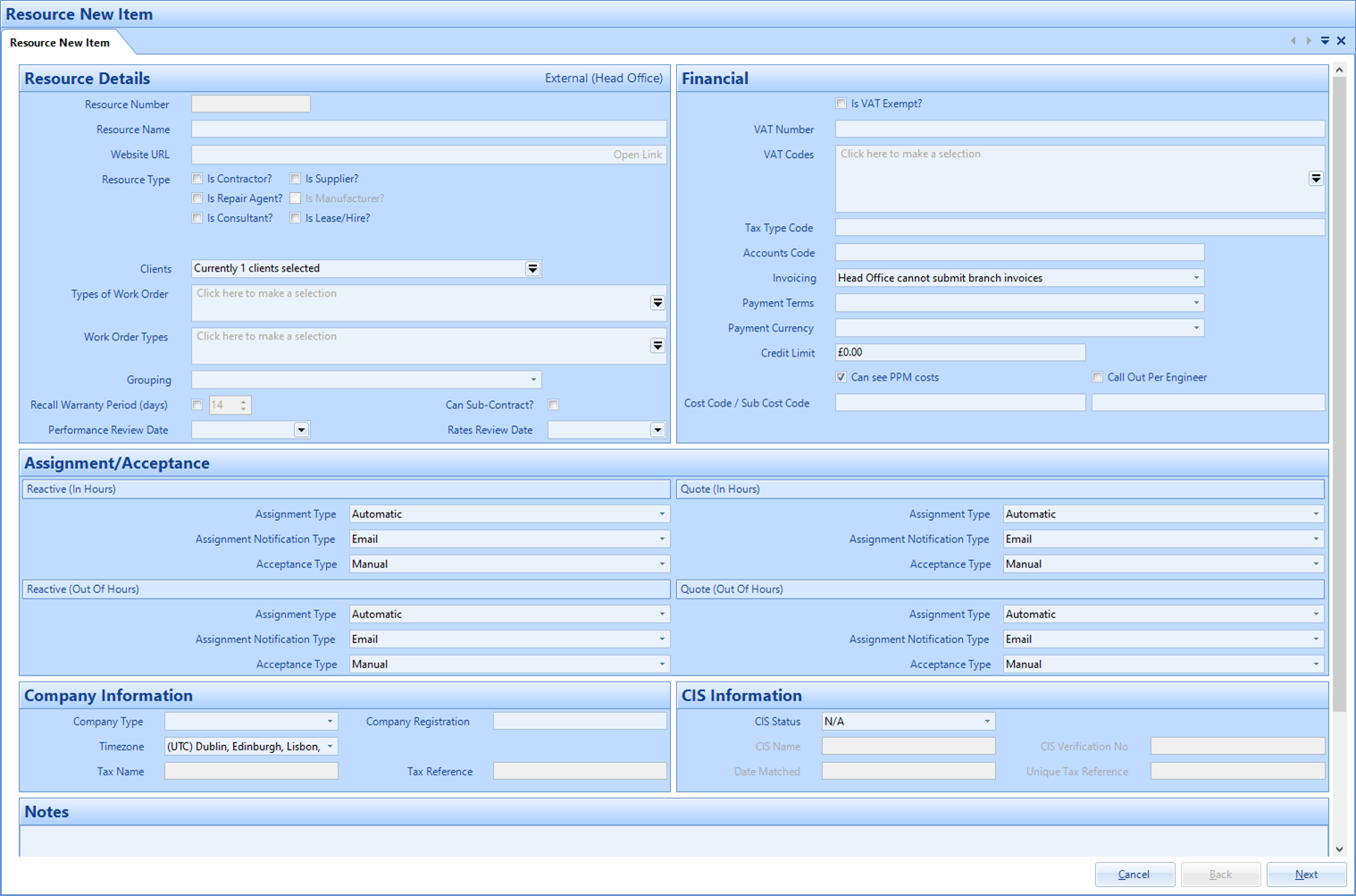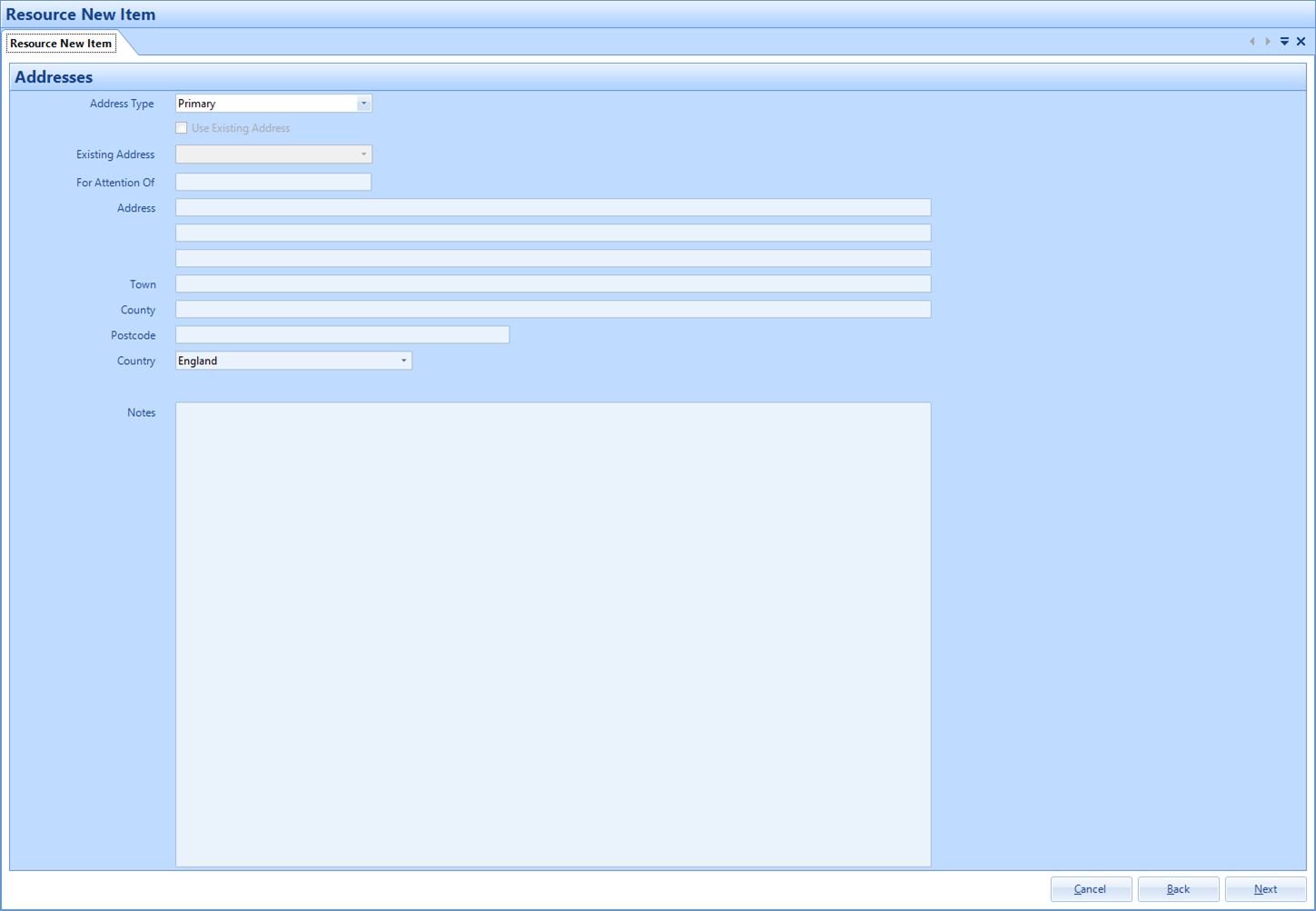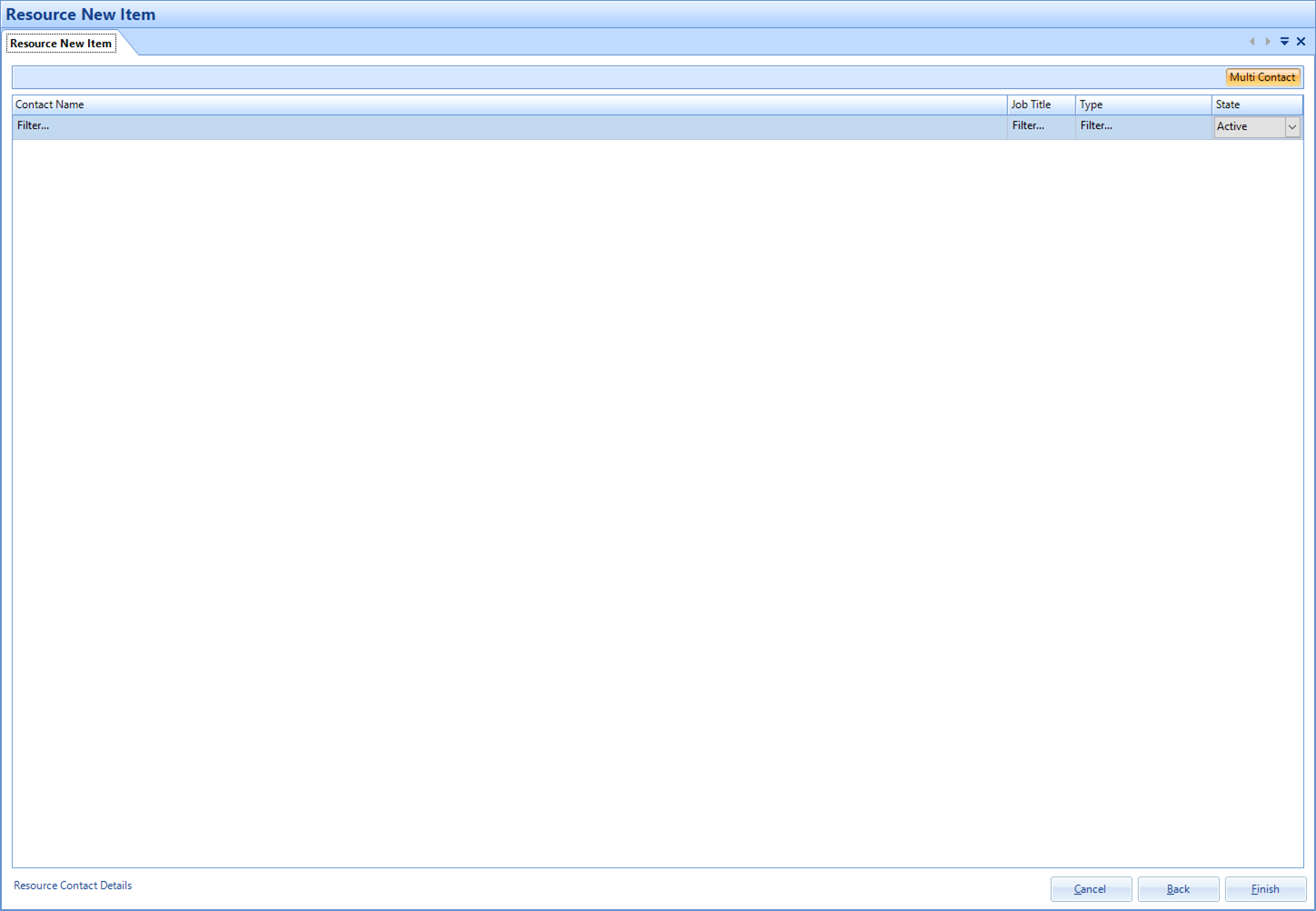Creating External Resources

Resource Name is a freeform field which should be used to enter the name of the Resource.
Website URL should be used to enter the website address of the Resource, if they have one.
Resource Type this is a tick choice of the different types of resource which can be created. A Resource can be multiple Types if applicable.
Is Contractor? – This means that the Resource is someone who attends and undertakes work at site.
Is Supplier? – This means that the Resource is someone who delivers goods to site only. Ticking this will enable the Purchasing sections on this screen (explained at the bottom of this page).
Is Repair Agent? – This means that the Resource is someone who doesn’t attend site, but repairs items off site.
Is Consultant? – This means that the Resource is someone who provides advice, may attend site, but does not log on or off work orders.
Is Lease/Hire? – This means that the Resource is someone who provides goods to site on a hire/lease basis.
Clients is a pop up selection of all of the Clients that the User has access to view. Select all of the Clients which the Resource could work for.
Note: When clicking on the down arrow, Users will initially be shown an Information box that states ‘Changing the clients for the resource will result in obsolete work order types being removed.’ Click the OK button to get the pop up box where it’s possible to add/remove Clients. For information on how to select a Client, see the Client Selection page.
Types of Work Order is a pop up selection of all of the Types of Work Order (e.g. Reactive, PPM, etc). The Types of Work Order selected should correspond with what the Resource can work on.
Note: If a Resource is NOT associated with a Type of Work Order such as Reactive, attempting to select that particular Resource to carry out any Reactive work will not be allowed.
Work Order Types is a pop up selection of all of the Work Order Types which are common across the Clients selected. The Work Order Types selected should correspond with what the Resource can work on.
Note: If a Resource is NOT associated with a Work Order Type such as BUILDING FABRICATION, selecting that particular Resource to carry out any work that is grouped under BUILDING FABRICATION will not be allowed.
Grouping is a drop down selection which allows the User to select the Resource Grouping this Resource belongs to. This Grouping field is a way of restricting user access to the financial information of particular Resources. By settings what Resource Groupings a particular Person has against their Person record, that Person will only then see financial information (rates, invoices, etc) of the Groupings they have access to.
Recall Warranty Period (days) is a tick box to detail what the recall period, for WOs for this Resource, is. Upon ticking it, the User is then able to enter the number of days. This can be entered by typing it in or by using the up and down arrows.
Assignment/Acceptance section contains four areas in which the User can decide the preferable assignment method for different Types of Work Orders, in or out of hours. The different areas are as follows:
· Reactive (In Hours) - This determines the assignment and acceptance methods for Reactive Work Orders assigned within the Resource’s working hours.
· Reactive (Out of Hours) - This determines the assignment and acceptance methods for Reactive Work Orders assigned outside of the Resource’s working hours.
· Quote (In Hours) - This determines the assignment and acceptance methods for Quote Work Orders assigned within the Resource’s working hours.
· Quote (Out of Hours) - This determines the assignment and acceptance methods for Quote Work Orders assigned outside of the Resource’s working hours.
Each area contains three drop downs:
· Assignment Type - This determines whether the assignment method for the Resource will be either "Manual" or "Automatic". If "Manual" is selected, the Work Order will need to be assigned manually by the Agent. If "Automatic" is selected, the Work order will be assigned as soon as the Resource is allocated.
· Assignment Notification Type - This determines how the Resource will be notified of their assignment on the Work Order. The options "None", "Email" or "Phone" are present.
· Acceptance Type - This determines whether the acceptance method for the Resource will be either "Manual" or "Automatic". If "Manual" is selected, the Resource will need to be accept the Work Order themselves. If "Automatic" is selected, the Work order will be accepted automatically once it has been assigned.
It is important that the method selected (for the relevant Type of Work Order and hours) has been agreed with the Resource, as this will impact the workload and effectiveness of the Helpdesk on both the Client and Resource side e.g. if Phone (Manual) is selected, jobs will have to be called through to the Resource whereas if Email (Automatic) is selected, the jobs will be automatically assigned to the Resource saving time and increasing efficiency on the Client side. This will only be effective if the Resource is monitoring and progressing jobs assigned to them by email in a timely manner however.
Note: In order for Work Orders to be assigned automatically, the User who performed the last task on the Work Order (that caused the assignment email to be sent) is required to have the permission "Can Set Assigned By Email" selected against their profile as well as the Resource having "Email (Automatic)" set against the Type of Work Order.
For example: if a Resource has an assignment method of "Email (Automatic)" for Quote Work Orders and an Authoriser authorises a Quote Work Order for that Resource, the email will only be sent if the Authoriser has the "Can Set Assigned By Email" selected. Otherwise, an agent will need to perform the assignment.
Is VAT Exempt? Is a tick choice to show if the Resource is exempt from VAT rules.
VAT Number is the field in which the Resources VAT code should be entered.
VAT Codes is a pop up selection of the different VAT codes which could be applied to the Resource. Tick all of the applicable codes and then select which one is the preferred rate. These codes are then applied when entering an invoice from the Resource.
Tax Type Code is a freeform field (20 characters) to enter the Tax Type, if applicable.
Accounts Code is a freeform field (30 characters) to enter the Accounts Code, if applicable.
Invoicing is a drop which details who will be submitting the invoices for the Resource. There are three options:
· Head Office Cannot Submit Branch Invoices - Selecting this means that any Branch Resources under this Resource will be responsible for submitting their own invoices and that the Head Office can only submit invoices for Head Office WOs.
· Head Office Can optionally Submit Branch Invoices - Selecting this means that the Head Office can submit Invoices for WOs for any Branches under them but the Branches can also submit their own.
· Head Office Must Submit Branch Invoices - Selecting this means that the Head Office is be responsible for submitting invoices on jobs for Branches, as well as their own. Branches cannot submit invoices.
Payment Terms is a drop down selection which allows the User to enter the agreed Payment Terms of the invoices for the Resource.
Payment Currency is a drop down selection which provides the ability to enter the agreed Payment Currency of the invoices for the Resource. The currency specified here will show on the Work Order when the Resource is selected and will always be the currency that appears associated with the Resource, even if they are selected for use in a country that has an alternative currency. E.G. if a Resource has been specified to be paid in pounds sterling and is selected for work in France, pounds sterling will appear on the Work order not Euros the currency of the country.
Credit Limit is a numerical field which provides the ability to enter the agreed credit limit with the Resource.
Can see PPM costs is a tick box that determines whether the PPM emails that are automatically generated to the Resource will contain the Cost column or not. By leaving this unticked, any PPM emails sent from the system to the Resource contacts will not contain PPM costs.
Call Out Per Engineer is a tick box that determines whether Call Out Fees on WOs for this Resource will be chargeable for each engineer on the WO. This is unticked by default meaning that there will only be one Call Out Fee charge per WO.
Cost Code / Sub Cost Code are numerical fields in which the User can enter the cost and sub cost codes for the Resource. Cost Code is on the left where Sub Cost Code is on the right.
Company Type is a drop down selection which provides the ability to state what type the Resource is.
Note: Remember that the Company Type selected will determine any additional information that needs to be completed.
Timezone is a drop down selection which provides the ability to state what time zone the Resource is situated in.
Company Registration is a freeform field in which the Company Registration number of the Resource should be entered.
CIS Status is a tick selection of the different types of CIS status. Tick the one that is relevant to the Resource, if any.
Tax Name is a text field which allows the User to enter the Resource Tax Name.
Tax Reference is a text field which allows the User to enter the Resource Tax Reference.
Notes is a freeform field for any additional information that is to be included on the specific Resource.
Note: Should a Resource be set as a "Supplier" then the Assignment/Acceptance section will change to display the following information:

Submission Type - This determines the submission type for Purchase Orders. This can be either "Automatic" or "Manual". If set to "Manual", Users will need to perform the submit action on the Purchase Orders to progress them.
Submission Notification Type - This determines the submission notification type for Purchase Orders. This can be either "Email", "Phone" or "None".
Acknowledge Type - This determines the acknowledgement type for Purchase Orders. This can be either "Automatic" or "Manual". If set to "Manual", Resources will need to acknowledge Purchase Orders to progress them.
Minimum Order Value - The Minimum Order Value is a numeric field that allows for the specification of a limit under which a new Purchase Order cannot be raised. This is to stop the creation of Purchase Orders for values lower than the Supplier would normally allow.
Click "Next" once all of the relevant details have been entered.

